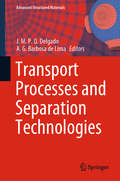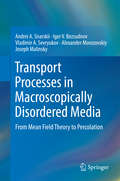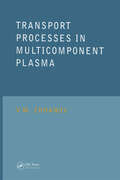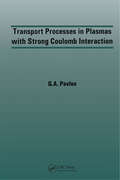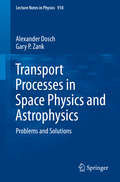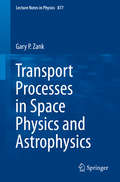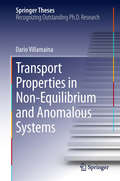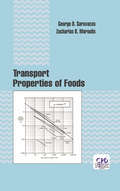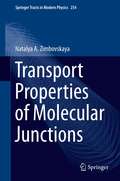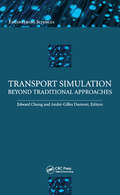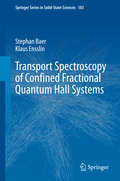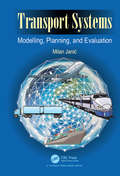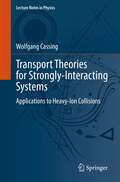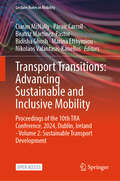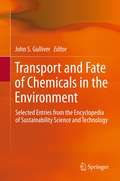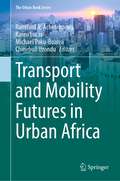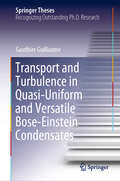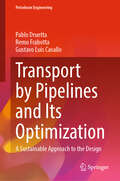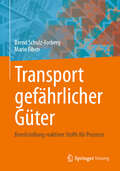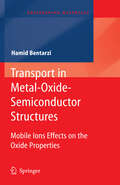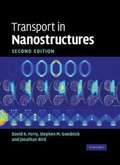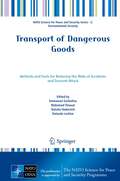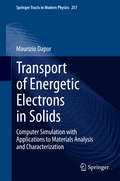- Table View
- List View
Transport Processes and Separation Technologies (Advanced Structured Materials #133)
by J. M. P. Q. Delgado A. G. Barbosa de LimaThis book presents recent research in the field of transport phenomena in porous materials, including heat and mass transfer, drying and adsorption. Covering a comprehensive range of topics related to the transport phenomenon in engineering (including state-of-the-art, theory and technological applications), it discusses some of the most important theoretical advances, computational developments and applications in porous materials domain. Providing an update on the current state of knowledge, this self-contained reference resource will appeal to scientists, researchers and engineers in a variety of disciplines, such as chemical, civil, agricultural and mechanical engineering.
Transport Processes at Fluidic Interfaces
by Dieter Bothe Arnold ReuskenThere are several physico-chemical processes that determine the behavior of multiphase fluid systems - e. g. , the fluid dynamics in the different phases and the dynamics of the interface(s), mass transport between the fluids, adsorption effects at the interface, and transport of surfactants on the interface - and result in heterogeneous interface properties. In general, these processes are strongly coupled and local properties of the interface play a crucial role. A thorough understanding of the behavior of such complex flow problems must be based on physically sound mathematical models, which especially account for the local processes at the interface. This book presents recent findings on the rigorous derivation and mathematical analysis of such models and on the development of numerical methods for direct numerical simulations. Validation results are based on specifically designed experiments using high-resolution experimental techniques. A special feature of this book is its focus on an interdisciplinary research approach combining Applied Analysis, Numerical Mathematics, Interface Physics and Chemistry, as well as relevant research areas in the Engineering Sciences. The contributions originated from the joint interdisciplinary research projects in the DFG Priority Programme SPP 1506 "Transport Processes at Fluidic Interfaces. "
Transport Processes in Macroscopically Disordered Media
by Andrei A. Snarskii Igor V. Bezsudnov Vladimir A. Sevryukov Alexander Morozovskiy Joseph MalinskyThis book reflects on recent advances in the understanding of percolation systems to present a wide range of transport phenomena in inhomogeneous disordered systems. Further developments in the theory of macroscopically inhomogeneous media are also addressed. These developments include galvano-electric, thermoelectric, elastic properties, 1/f noise and higher current momenta, Anderson localization, and harmonic generation in composites in the vicinity of the percolation threshold. The book describes how one can find effective characteristics, such as conductivity, dielectric permittivity, magnetic permeability, with knowledge of the distribution of different components constituting an inhomogeneous medium. Considered are a wide range of recent studies dedicated to the elucidation of physical properties of macroscopically disordered systems. Aimed at researchers and advanced students, it contains a straightforward set of useful tools which will allow the reader to derive the basic physical properties of complicated systems together with their corresponding qualitative characteristics and functional dependencies.
Transport Processes in Multicomponent Plasma
by V.M. ZhdanovTransport Processes in Multicomponent Plasma is a revised and updated version of the original Russian edition. The book examines transport phenomena in multicomponent plasma and looks at important issues such as partially ionized gases, molecular gas mixtures and methods of calculating kinetic coefficients. It makes a logical progression from simpl
Transport Processes in Plasmas with Strong Coulomb Interactions
by G.A. PavlovThe first part of this monograph presents theoretical analysis of the thermophysical properties of strongly coupled coulomb systems. A new model is then developed, making it possible to calculate the full set of low temperature, multicomponent, nonideal plasma transport coefficients, based on the kinetic coefficients of strongly coupled coulomb sys
Transport Processes in Porous Media
by J.M.P.Q. Delgado Frank A. CoutelierisThe subject of this book is to study the porous media and the transport processes occur there. As a first step, the authors discuss several techniques for artificial representation of porous. Afterwards, they describe the single and multi phase flows in simplistic and complex porous structures in terms of macroscopic and microscopic equations as well as of their analytical and numerical solutions. Furthermore, macroscopic quantities such as permeability are introduced and reviewed. The book also discusses with mass transport processes in the porous media which are further strengthen by experimental validation and specific technological applications. This book makes use of state-of-the-art techniques for the modeling of transport processes in porous structures, and considers of realistic sorption mechanisms. It the applies advanced mathematical techniques for upscaling of the major quantities, and presents the experimental investigation and application, namely, experimental methods for the measurement of relevant transport properties. The main benefit of the book is that it discusses all the topics related to transport in porous media (including state-of-the-art applications) and presents some of the most important theoretical, numerical and experimental developments in porous media domain, providing a self-contained major reference that is appealing to both the scientists and the engineers. At the same time, these topics encounter a variety of scientific and engineering disciplines, such as chemical, civil, agricultural, mechanical engineering. The book is divided in several chapters that intend to be a resume of the current state of knowledge for benefit of related professionals and scientists.
Transport Processes in Space Physics and Astrophysics
by Alexander Dosch Gary P. ZankThis is the problems and solution manual for the graduate text with the same title and published as Lecture Notes in Physics Vol 877 which provides the necessary mathematical and physics background to understand the transport of gases, charged particle gases, energetic charged particles, turbulence, and radiation in an astrophysical and space physics context. The very detailed and self-contained problems and solutions will be an essential part of the training of any graduate student wishing to enter and pursuing research in this field.
Transport Processes in Space Physics and Astrophysics
by Gary P. Zank"Transport Processes in Space Physics and Astrophysics" is aimed at graduate level students to provide the necessary mathematical and physics background to understand the transport of gases, charged particle gases, energetic charged particles, turbulence, and radiation in an astrophysical and space physics context. Subjects emphasized in the work include collisional and collisionless processes in gases (neutral or plasma), analogous processes in turbulence fields and radiation fields, and allows for a simplified treatment of the statistical description of the system. A systematic study that addresses the common tools at a graduate level allows students to progress to a point where they can begin their research in a variety of fields within space physics and astrophysics. This book is for graduate students who expect to complete their research in an area of plasma space physics or plasma astrophysics. By providing a broad synthesis in several areas of transport theory and modeling, the work also benefits researchers in related fields by providing an overview that currently does not exist. For numerous interesting and challenging space physics and astrophysics problems, there is a need to describe the "long-term" behavior of systems governed by macroscopic laws and microscopic randomness. A random event has an outcome that is uncertain and unpredictable, yet the collective behavior of a system can be governed by well defined mathematical and physical principles. Examples of physical problems include the behavior of gases in the presence of microscopic inter-particle collisions, the evolution of a gas of charged protons and electrons (a plasma), the collective propagation of solar energetic particles or cosmic rays in a magnetically turbulent medium, the collective behavior of dust in an accretion disk subject to coagulation and destruction, the evolution of low-frequency magnetic field turbulence in the inhomogeneous solar wind, or the transport of photos in a partially ionized interstellar medium. This book provides graduate students with a unified introduction to the physics of collective phenomena or transport processes for gases (charged and uncharged), fields, and photons in a space physics or astrophysics context.
Transport Properties in Non-Equilibrium and Anomalous Systems
by Dario VillamainaThe study of fluctuations in statistical physics has a long history, and a general theory is well established, connecting fluctuations to response properties of equilibrium systems. Remarkably, this framework fails as soon as some current is flowing across the system, driving it out of equilibrium. The presence of currents is quite common in nature and produces rich phenomena which are far from being included in a general framework. This thesis focuses on this general problem by studying different models such as granular materials and systems exhibiting anomalous diffusion and shows how the generalized response techniques can be successfully used to catch the relevant degrees of freedom that drive the systems out of equilibrium. This study paves the way to the use of the generalized fluctuation relations in an operative way, in order to extract information from a non-equilibrium system and to build the corresponding phenomenological theory.
Transport Properties of Foods (ISSN)
by George D. Saravacos Zacharias B. MaroulisThis study covers all the transport properties of food materials and systems - exploring viscosity, moisture diffusivities, thermal conductivity and diffusivity, transport and permeability of small molecules, and heat and mass transfer coefficients. The authors provide physical, mathematical or empirical models of the transport processes for each application, as well as principal property values and measuring methods for various food products and systems.
Transport Properties of Molecular Junctions
by Natalya A. ZimbovskayaA comprehensive overview of the physical mechanisms that control electron transport and the characteristics of metal-molecule-metal (MMM) junctions. As far as possible, methods and formalisms presented elsewhere to analyze electron transport through molecules are avoided. This title introduces basic concepts--a description of the electron transport through molecular junctions--and briefly describes relevant experimental methods. Theoretical methods commonly used to analyze the electron transport through molecules are presented. Various effects that manifest in the electron transport through MMMs, as well as the basics of density-functional theory and its applications to electronic structure calculations in molecules are presented. Nanoelectronic applications of molecular junctions and similar systems are discussed as well. Molecular electronics is a diverse and rapidly growing field. Transport Properties of Molecular Junctions presents an up-to-date survey of the field suitable for researchers and professionals.
Transport Simulation: Beyond Traditional Approaches
by Edward ChungIn recent years, the transport simulation of large road networks has become far more rapid and detailed, and many exciting developments in this field have emerged. Within this volume, the authors describe the simulation of automobile, pedestrian, and rail traffic coupled to new applications, such as the embedding of traffic simulation into driving simulators, to give a more realistic environment of driver behavior surrounding the subject vehicle. New approaches to traffic simulation are described, including the hybrid mesoscopic-microscopic model and floor-field agent-based simulation. Written by an invited panel of experts, this book addresses students, engineers, and scholars, as well as anyone who needs a state-of-the-art overview of transport simulation today.
Transport Spectroscopy of Confined Fractional Quantum Hall Systems
by Klaus Ensslin Stephan BaerThis book provides an overview of recent developments in experiments probing the fractional quantum Hall (FQH) states of the second Landau level, especially the \nu=5/2 state. It summarizes the state-of-the-art understanding of these FQH states. It furthermore describes how the properties of the FQH states can be probed experimentally, by investigating tunneling and confinement properties. The progress towards the realization of an experiment, allowing to probe the potentially non-Abelian statistics of the quasiparticle excitations at \nu=5/2 is discussed. The book is intended as a reference for graduate students, PostDocs and researchers starting in the field. The experimental part of this book gives practical advice for solving the experimental challenges which researchers studying highly fragile FQH states are faced with.
Transport Systems: Modelling, Planning, and Evaluation
by Milan JanicThe transport sector consists of different modes of transport, each serving a growing demand for transporting people and goods. This (growing) demand on the one hand, needs expanding the systems’ capacity, and on the other hand, increasing the corresponding economic efficiency, effectiveness, and environmental and social friendliness. This implies development of a ‘greener’, i.e. a more sustainable transport sector. The book describes the current and prospective state of the art analytical modelling, conceptual planning, and multi-criteria evaluation of the selected cases of transport systems operated by different transport modes such as road, rail, sea, air, and intermodal. As such, the book is unique in addressing these three important aspects of dealing with transport systems before implementation of their particular components means by the selected cases. It will be particularly useful for readers from the academia and the professionals from the transport sector.
Transport Theories for Strongly-Interacting Systems: Applications to Heavy-Ion Collisions (Lecture Notes in Physics #989)
by Wolfgang CassingThis book provides an overview on transport theories, focusing on applications and the relativistic off-shell transport theory which are of particular interest for physicists working in the field of relativistic strong-interaction physics, e.g. relativistic or ultra-relativistic heavy-ion collisions or the evolution of the early universe. In this regard, a thorough derivation of the transport equations and a careful analysis of the approximations employed is given. The text is enriched with a multitude of Appendices that partly recall elements of quantum mechanics and field theory or present examples for specific models. Specific exercises are given throughout the chapters. As a basic knowledge the reader should be familiar with quantum mechanics and its principles as well as some basic concepts of the quantum many-body physics and field theory. All chapters close with a short summary and numerical calculations are provided to master and illustrate the subject.
Transport Transitions: Proceedings of the 10th TRA Conference, 2024, Dublin, Ireland - Volume 2: Sustainable Transport Development (Lecture Notes in Mobility)
by Bidisha Ghosh Marina Efthymiou Ciaran McNally Páraic Carroll Beatriz Martinez-Pastor Nikolaos Valantasis-KanellosThis is an open access book. It gathers the proceedings of the 10th edition of Transport Research Arena (TRA 2024), held on 15-18 April, 2024, in Dublin, Ireland. Contributions cover a wide range of research findings, methodological aspects, technologies and policy issues that are currently reshaping the transport and mobility system in different parts of Europe. Bridging between academic research, industrial developments, and regulations, this book offers a comprehensive review of the state-of-the art in transportation, with a special emphasis on topics concerning digital transition in transport, and inclusive and sustainable mobility alike. This is the second volume of a 6-volume set.
Transport and Fate of Chemicals in the Environment
by John S. GulliverWhat happens when a chemical is released into the environment? It diffuses, disperses, adsorbs, reacts, and/or changes state. To predict and analyze this process, the mathematics of diffusion is applied to lakes, rivers, groundwater, the atmosphere, the oceans, and transport between these media. A sustainable world requires a deep understanding of the transport of chemicals through the environment and how to address and harness this process. This volume presents a succinct and in-depth introduction to this critical topic. Featuring authoritative, peer-reviewed articles from the Encyclopedia of Sustainability Science and Technology, Transport and Fate of Chemicals in the Environment represents an essential one-stop reference for an audience of researchers, undergraduate and graduate students, and industry professionals.
Transport and Mobility Futures in Urban Africa (The Urban Book Series)
by Karen Lucas Ransford A. Acheampong Michael Poku-Boansi Chinebuli UzonduThis book provides a collection of insightful conceptual and empirical works that situate transport and mobility challenges in the unique context of individual countries and cities while highlighting commonalities across the African continent. Written from an interdisciplinary perspective, the book covers important themes in transport and mobility including the links between urbanization, urban structure, and accessibility; transport equity and poverty, non-motorized transport, public transport, and the challenges and opportunities of new and emerging transport technologies, and ICT-mediated mobility solutions. Each chapter engages with the normative imperatives that are critical to improving the transport and mobility situations of African urban areas now and in the future.
Transport and Turbulence in Quasi-Uniform and Versatile Bose-Einstein Condensates (Springer Theses)
by Gauthier GuillaumeAdvancing the experimental study of superfluids relies on increasingly sophisticated techniques. We develop and demonstrate the loading of Bose-Einstein condensates (BECs) into nearly arbitrary trapping potentials, with a resolution improved by a factor of seven when compared to reported systems. These advanced control techniques have since been adopted by several cold atoms labs around the world.How this BEC system was used to study 2D superfluid dynamics is described. In particular, negative temperature vortex states in a two-dimensional quantum fluid were observed. These states were first predicted by Lars Onsager 70 years ago and have significance to 2D turbulence in quantum and classical fluids, long-range interacting systems, and defect dynamics in high-energy physics. These experiments have established dilute-gas BECs as the prototypical system for the experimental study of point vortices and their nonequilibrium dynamics. We also developed a new approach to superfluid circuitry based on classical acoustic circuits, demonstrating its conceptual and quantitative superiority over previous lumped-element models. This has established foundational principles of superfluid circuitry that will impact the design of future transport experiments and new generation quantum devices, such as atomtronics circuits and superfluid sensors.
Transport by Pipelines and Its Optimization: A Sustainable Approach to the Design (Petroleum Engineering)
by Pablo Druetta Remo Frabotta Gustavo Luis CavalloThis textbook introduces pipeline design, one of the most efficient techniques for mass and energy transport available today. The global economy heavily relies on pipelines. However, designing a pipeline is more complex than it might seem; it involves many technical and economic factors that must work together to create an optimized system. The book begins with basic concepts of pipelines, including a description of the materials used, heat transfer between the system and medium, and the main components of pumping and compression stations, which are vital for the subsequent chapters. It then presents a simple yet detailed overview of these factors and introduces a mathematical methodology that combines them to deliver an optimized pipe design, minimizing costs and reducing energy consumption. The book also covers the transient verification of this design using well-known balance equations and material property relationships for both incompressible and compressible fluids, to validate the initial design. Finally, the book explores the analysis of multiphase pipelines, where the goal is to transport a particular material (e.g., solid) using a different medium (e.g., air or water).
Transport gefährlicher Güter: Bereitstellung reaktiver Stoffe für Prozesse
by Bernd Schulz-Forberg Mario EibenDer Inhalt dieses Buches fasst zunächst die Vorlesungen zum Transport gefährlicher Güter an den folgenden Hochschulen zusammen: Hochschule für Wirtschaft und Recht (HWR) Berlin im Studiengang BWL/Spedition und Logistik (Bachelor), Hochschule Furtwangen (HFU) im Studiengang Safety & Security (Master) und Berliner Hochschule für Technik (BHT) im Studiengang Verpackungstechnik (Bachelor). Die etwa 30 Stunden umfassende Vorlesung war von den Industrie- und Handelskammern in Reutlingen und Berlin (nur HWR) als Schulungsveranstaltung für Gefahrgutbeauftragte nach der Gefahrgutbeauftragtenverordnung (GbV) für die Studierenden für den Bereich Straße anerkannt worden. Studierende konnten sich nach der Vorlesung zur Prüfung bei der IHK anmelden und die Prüfung ablegen. Ferner erlaubt der Inhalt des Buches einen orientierenden Einblick in die Gestaltung der Regeln des Gefahrguttransportes, also der Rechtsvorschriften und der begleitenden Normung. Am Ende finden sich Überlegungen für die weitere Vorgehensweise für die Regelungen in der Zukunft.
Transport in Metal-Oxide-Semiconductor Structures
by Hamid BentarziThis book focuses on the importance of mobile ions presented in oxide structures, what significantly affects the metal-oxide-semiconductor (MOS) properties. The reading starts with the definition of the MOS structure, its various aspects and different types of charges presented in their structure. A review on ionic transport mechanisms and techniques for measuring the mobile ions concentration in the oxides is given, special attention being attempted to the Charge Pumping (CP) technique associated with the Bias Thermal Stress (BTS) method. Theoretical approaches to determine the density of mobile ions as well as their distribution along the oxide thickness are also discussed. The content varies from general to very specific examples, helping the reader to learn more about transport in MOS structures.
Transport in Nanostructures
by David K. Ferry Stephen M. Goodnick Jonathan BirdProviding a much-needed update on the latest experimental research, this new edition has been thoroughly revised and develops a detailed theoretical framework for understanding the behavior of mesoscopic devices.
Transport of Dangerous Goods
by Dalanda Lachtar Mohamed Tkiouat Natalia Yankevich Emmanuel GarbolinoThis book addresses the various risks associated with the transport of dangerous goods within a territory. The emphasis of the contributions is on methods and tools to reduce the vulnerability of both the environment and human society to accidents or malicious acts involving such transport. With topics ranging from game theory to governance principles, the authors together cover technical, legal, financial, and logistic aspects of this problem. The intended audience includes responsible persons in territorial organizations, managers of transport infrastructures, as well as students, teachers and researchers wishing to deepen their knowledge in this area.
Transport of Energetic Electrons in Solids
by Maurizio DaporThis book presents the potential of the Monte Carlo (MC) technique to solve mathematical and physical problems of great complexity. This book focusses on the study of the electron-solid interaction (transport MC) and presents some physical problems related to the transport of hot electrons in solid targets using transport MC. The numerical and theoretical results are validated through a comparison with experimental results. The author also addresses methodological aspects. In particular, systematic comparisons among different calculation schemes are presented. Different expressions for the calculation of cross sections and/or stopping power and different simulation methods are described and discussed.
